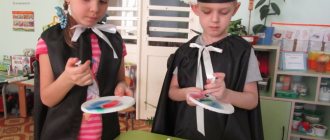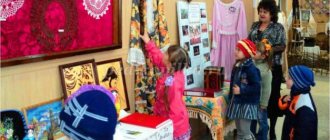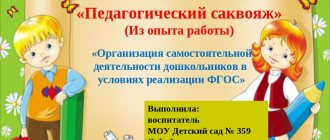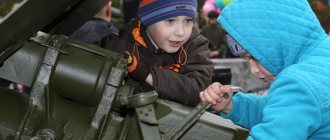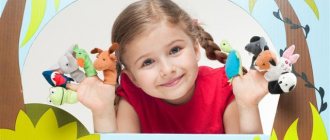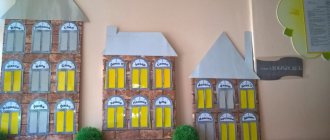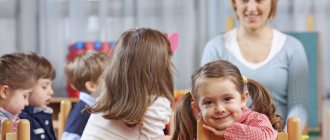Types of joint activities between children and parents
Types of joint activities of children with parents.
Organization of holidays:
children's birthday, Christmas holidays, Children's Day, Holiday of knowledge.
The holiday atmosphere will definitely bring adults and children closer together in preparing the environment, writing a script, creating a menu, and making prizes. It is better if each family member independently prepares competitions, costumes, games, surprises, and takes an active part.
Creativity
The child himself must become the initiator of such activities. The parent joins in the creative work offered by the child. At the same time, an adult can offer his own projects: making a collage from natural materials, publishing a family wall newspaper, making greeting cards. This promotes the development of children's imagination, independence and self-expression.
Reading books
There is a “Reading Hour” of books of the child’s choice or a special ritual before bedtime. At such moments, along with the development of the cognitive sphere, the child develops moral and personal qualities without direct moral teaching. And most importantly, at such moments the child has a desire to talk about his secrets and problems.
Cooperative games
Board games such as: lotto, dominoes; printed board games; verbal-logical, etc. enhance close interaction between children and parents. Play is a very pleasant activity for a child, within which he develops and at the same time is educated. During play with a child, an adult finds himself in a situation “on equal terms.” And when the child explains the course and rules of the game, the adult falls into the role of “learner.” In joint play activities, the formation of moral and volitional qualities of the child’s personality occurs.
Theatricalization
Children are fans of dressing up and transforming using the wardrobe of adults. Of course, at such moments the child needs spectators, who become parents. In such activities, children realize themselves and become liberated, practicing and acquiring new forms of communication.
Family excursions and trips
Such trips can be organized to a park, a forest, or a museum. The parent acts as the leader, and the child is involved in planning the route: where they will go, what to take from food, toys. During the excursion, the adult encourages the child to be active in learning about the environment.
Visiting theaters and cinemas
At the initial stage, the initiator of such visits is the parents, introducing the child to the world of beauty. Then the children themselves choose the place and topics of viewing.
Maintaining family albums, filling out the “Album of Discoveries”
This is an interesting, exciting activity between parents and a child, through which adults become clearer and closer to their children, and children become closer to adults, which helps strengthen family relationships. By getting to know himself, the world around him, and other people, a child can at any moment receive understanding and support from a loved one.
Joint play activities of parents and children (from work experience)
This is my first year working with my group of children and parents.
I started by deciding to establish a trusting relationship with my parents. In modern conditions of a kindergarten it is so difficult to do without the support of parents, without their participation in the life of the group and kindergarten. Only through joint efforts can we raise a person who has a thirst for knowledge, knows how to enjoy life and sympathize, who can do anything! After all, it is through interaction and cooperation with parents that one can achieve the full development of a child and his proper upbringing. Interaction should be based on the principles of joint activities of educators, parents and children. At the same time, the goal of family education, as well as public preschool education, should be the development of the child’s personality.
The great Russian teacher V.A. Sukhomlinsky wrote: “Education is, first of all, human studies. Without knowledge of the child - his mental development, thinking, interests, hobbies, abilities, inclinations, inclinations, there is no education... Without constant spiritual communication between teacher and child, without mutual penetration into the world of each other’s thoughts, feelings, experiences, emotional culture as the flesh and blood of culture is unthinkable pedagogical". Of course, he wrote about teachers and educators, but we must not forget that the first teachers and educators for a child are his parents.
But modern parents, for some reason, forget about this and leave the upbringing, education and development of their children to general education institutions. I ran into a problem: parents show little interest in the success of their children. It is very difficult to attract and interest them, but this is the most important task. It is sometimes so difficult to explain to parents that the child must not only be fed, clothed, and put to bed, but also communicate with him, teach him to reflect, think, and empathize. And how great it is to do everything together - play, walk, talk about different topics, share secrets, come up with different stories, do crafts. This is what I want to convey to the parents of my students by holding unusual conversations with them, consultations, seminars, workshops, parent meetings on various interesting topics that concern them so much. I rely on the requests of parents, and these requests are easy to identify through questionnaires, and sometimes I cover those topics and questions that are of interest to us educators and, I think, will be of interest to parents.
Yes, parents now are all literate people, with higher education, but, according to my observations, they do not know how to build relationships with children in play activities. But play is one of the leading activities of a child. Now the children stop playing. And the games children play have become sad and aggressive. The chain of transmission of gaming tradition from one generation to another has been broken. I decided to bring children and parents closer together, to show parents that their children are creative and capable, but they require attention and a partner to play with.
To solve this problem, I set myself the following tasks in working with parents:
1. To develop in parents confidence in their own pedagogical capabilities, the ability to know and understand their children.
2. Enrich the emotional joint experience of family members, teach interaction skills between them through gaming activities.
3. Develop an interest in children and parents in spending time together.
4. To unite parents and children, to ensure that children understand their parents, and parents understand their children.
5. Introduce parents to the traditions and forms of gaming leisure in families.
6. Help parents discover new opportunities for the child to reflect the world in play.
In order to find out the meaning of joint games in the families of my students, I conducted a survey of parents and children “Game in the life of my family.” Based on the results of the survey, I concluded that parents want to play with their children, but do not know how to properly organize joint play activities with their children.
I drew up a plan for joint gaming activities, where parents will be partners, participants in children’s games, and not spectators or observers.
Prepared consultations for parents “Growing up while playing”, “What toys do your children need?” The goals of these consultations are: to make parents understand what role play plays in the child’s life; give knowledge about the meaning of the toy, its role in the child’s play.
My next step was to hold a parent meeting in the form of an oral journal on the topic “Why does a person need childhood?” At the meeting, questions were discussed: do parents remember their childhood, what is characteristic of it? What interests and worries their child? How would they like it to be? At the meeting, parents got acquainted with the statements of teachers and scientists about the game and its role in the life of the child. At the end of the meeting, parents received instructions on “How to play with your child correctly.”
There are many forms of organizing joint work between educators and parents. One of these forms is holding competitions, entertainment, holidays among parents, among parents and employees, etc. in kindergarten. The kindergarten traditionally celebrates the New Year on March 8 and February 23. But I realized that children’s lives become more interesting if we organize some non-standard, fun holidays, to which parents are invited not only as spectators, but also as participants.
A holiday is a bright event in a child’s life, filled with unusual, joyful and deep impressions. K.D. Ushinsky wrote: “Let everyone remember his childhood, and he will see that a holiday for a child is not at all the same as for us, that this is really an event in a child’s annual life, and that a child counts the days from holiday to holiday, just like we do.” We count our years from one important event to another.” I agree with him. But the holiday is doubly interesting for children if parents take part in it.
It has become a good tradition for our group to hold parent-child celebrations. This is a good reason to spend them with your parents, not for them. The scenarios are drawn up in such a way that parents are direct participants in the holiday. This involves cooperation with parents and communication with children through joint activities. Such holidays take more than one day to prepare. This is painstaking work. It is necessary to think over the organization of the holiday, the decoration of the hall, develop a script, etc. With children, before each event, I make invitations for parents. How nice it is to see the joyful faces of parents when their child presents an invitation made with their own hands! It would be a shame not to come and take part in order to please your son or daughter.
Holidays: “Autumn Birthday”, “Christmas Tree Festival”; leisure activities: “Together with Mom”, “Wide Maslenitsa”; entertainment: “Winter fun”, “Mom is my sunshine”, “Dad can do anything!” and others were held with various attractions, competitions, competitions, relay races and other game subjects. Mothers, grandmothers, fathers and their children took part in them. These events not only bring parents and children together, but also create an atmosphere of warmth and trust in the relationship between the teacher and parents. You learn a lot of interesting things about the families of your students, about their traditions, hobbies, about the system of raising children in the family, and most importantly, parents reveal their talents and creative abilities that they didn’t even know about. The unique emotional and spiritual atmosphere of the holiday is created by the general mood and activity of all participants in the holiday: children, parents, teachers. Joint holidays with parents remain in the memory of adults and children for a long time. They teach the child to love and take care of his family, his father and mother, the spirit of his home. Parents get to know each other well in joint competitions, competitions, and relay races. Adults and children learn to understand each other better, and parents have the opportunity to observe their child’s interactions with others. Children see a positive example of communication and relaxation.
I saw that as a result of such events, parents changed their attitude towards the child (he can and knows a lot) and towards us, the educators who work with their children every day, putting their soul, knowledge and strength into the work of education.
A special place is occupied by exhibitions of joint creativity between parents and children, for example, “Autumn is a Magician”, “Magic Snowflake”, “Crazy Hands”. The main goal of such events is to bring generations (children, parents, grandparents) closer together and strengthen child-parent relationships. In addition, exhibitions of joint creativity foster hard work, accuracy, attention to loved ones, and respect for work. This is the beginning of patriotic education, because love for the Motherland is born from a feeling of love for parents, one’s family.
Especially loved by children are “Meetings with Interesting People”, where their guests are parents who introduce themselves to children in a different way - as professionals in their field, interesting people. For example, the guests of our group were my mother, a doctor from a railway clinic, and my father, a builder. Such meetings enrich children's knowledge about the professional activities of adults, expand their general awareness of the world around them and their horizons, and also form in them a certain elementary experience of professional actions and promote early “professional orientation.” Role-playing games of a professional orientation play a major role in shaping children’s ideas about the professional activities of adults. Therefore, the result of such meetings are role-playing games, for example, “Polyclinic”, “Why should we build a house?”
I also plan to invite my grandmother to visit, who will show her crocheting skills; a mother who agrees to organize a “Balloon Festival” for the children.
We must not forget that our kindergarten is from the railway. I plan to hold a literary lounge “Here is our train rushing, the wheels are knocking...”, where parents and children will read poems, fairy tales, stories about the railway, their own compositions.
I believe that thanks to such events I create conditions for interaction between children and parents, which helped improve emotional contact between them and taught them how to play together.
Author: Irina Aleksandrovna Safarova, teacher, NDOU “Kindergarten No. 118 of JSC Russian Railways”, Samara, Russia.
The article is published in the author's edition.
The importance of joint creativity of children and parents in the development of the child’s personality
The importance of joint creativity of children and parents in the development of the child’s personality
Author: Karakozova Mlada Vebertovna, teacher, MADOU “Kindergarten No. 14 of a general developmental type.” Description: a description of the experience of working with photographs of crafts made by children aged 3-4 years and parents (joint creativity) is presented. The material will be useful to preschool teachers and parents. The most important requirement that a modern kindergarten must meet today in order to ensure the holistic development of the child’s personality is the development of constructive interaction with the family. In the approximate basic general educational program of preschool education “FROM BIRTH TO SCHOOL”, one of the main tasks is : attracting families of pupils to participate in joint events with teachers, creating conditions for cooperation that is diverse in content and forms, promoting the development of constructive interaction between teachers and parents with children, the emergence of a feeling of unity, joy, pride in the results obtained. Such events include exhibitions of joint creativity between children and parents for holidays, which we try to hold more often at the preschool educational institution. For a long time, psychologists and teachers have unanimously argued that joint creativity between children and parents forms good trusting relationships between them, has a positive impact on the development of the child and teaches him to cooperate. The creative process stimulates the all-round development of the child: motor skills are improved, imagination is formed, and creative potential is revealed. In addition, joint creative activity is an interesting pastime . We invited parents (together with children 3-4 years old) to create an exhibition of crafts for Defender of the Fatherland Day. The crafts turned out to be interesting: airplanes, tanks, a military vehicle, paratroopers, a cavalryman on horseback, a border outpost, a rocket, a steam locomotive, a complex technical design “Smart Ball” (battery-powered), and even a musketeer (we will later study the history of the holiday!) . When making crafts, children and parents used a variety of materials: cardboard, paper, feathers, pebbles, polystyrene foam, clothespins, yarn, toothpicks, plasticine (simple, sculptured, ball), caps from felt-tip pens, animal figurines, caps from plastic bottles, wire, wooden blocks, boxes, etc. I present the crafts:
Aircraft:
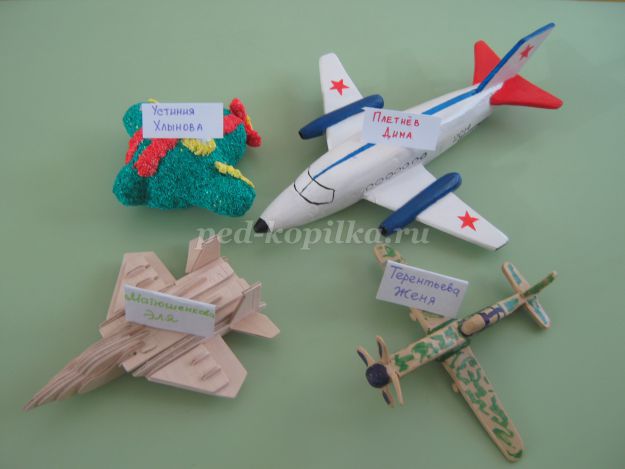
Tanks and military vehicle:

Paratroopers:
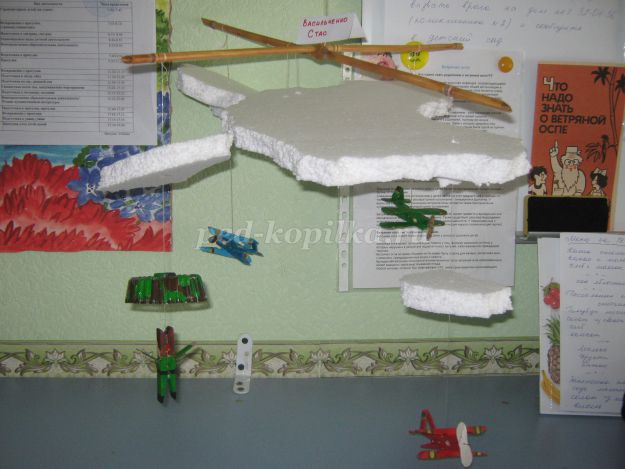
Cavalryman on horseback, border outpost, rocket, locomotive, musketeer:
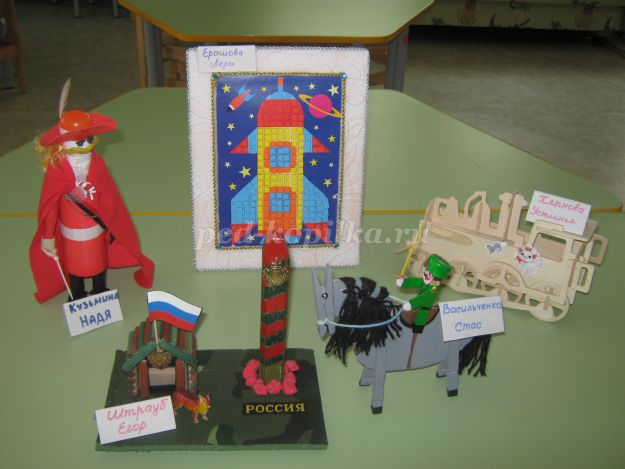
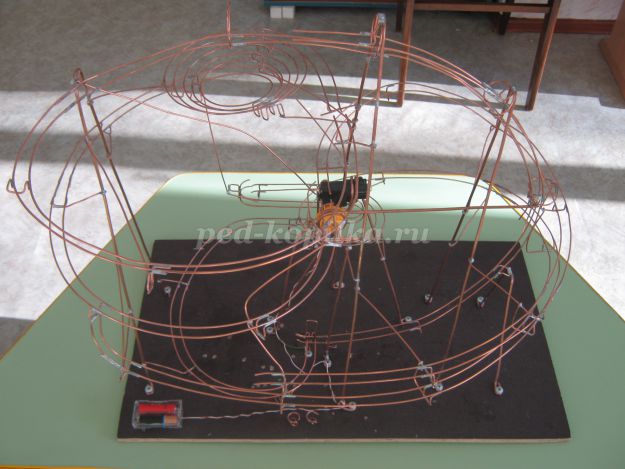
The exhibition turned out great! Children and adults enjoyed what they saw and were in a good mood!
We recommend watching:
DIY gift for February 23rd for dad Crafts for February 23rd in the middle group. Cardboard tie Using modular origami in working with children Workshop for parents in the senior group of kindergarten on the topic: New Year
Similar articles:
February 23. Scenario for the senior group of kindergarten
Scenario February 23 in the preparatory group of the preschool educational institution
Lesson in the senior group of kindergarten on the topic of February 23
Defender of the Fatherland Day in kindergarten. Scenario
Scenarios for February 23 in kindergarten
Working with children: the benefits of joint creativity and reading
“Joint work unites,” said Cat Matroskin from Prostokvashino. Psychologists are sure that it is not only work that unites, but also any joint activity between parents and children.
The modern rhythm of life dictates its conditions today. We are constantly in a hurry to get somewhere, trying to finish as many things as possible. The lion's share of which is organizing leisure time for our children. At the same time, the upbringing and care of many parents comes down to dividing their children into clubs and sections: kindergarten or school is replaced by gymnasiums and foreign language schools, and then they need to be on time for dancing or boxing training. But gatherings together, reading books, and even more so doing creative work together are becoming literally relics of the past.
Many mothers are sure that there is nothing better for a child to study with an all-knowing teacher who knows various methods and technologies for raising children. However, today many psychologists and teachers assure that the presence of children and parents together brings much more benefits.
Of course, no one is saying that you need to give up some additional activities. And yet, even the simplest activity at home with the mother can be one of the best ways in the development of the child. For example, in preschool age, adults can teach a child to see the unusual in the simple: a cone can easily become a hedgehog, semolina can become snow, and so on. And how great it would be if it was the mother who taught all this to her baby, and not someone else’s aunt, even with a special education.
No imagination? The Internet can help you. Today, in its vastness you can find so many ideas for joint creativity that classes can be held all day long.
No time? Believe me, you spend much more on travel to the circle/section and back. But let's get back to creativity. As a child grows up, the ability to see the unusual in ordinary things is transformed into a non-standard vision of the picture of the world, the ability to find a way out of atypical situations.
Collaborative creativity can become the basis for a trusting relationship. Here you and your child are drawing, for example, a snowman. And instead of white, he makes it black. There is no need to scold for choosing the wrong color, but it is better to find out why this particular choice was made. Perhaps this is how the baby wants to show you his problems in kindergarten. Thus, a conversation that starts by chance can become the basis of a deep, trusting relationship between you, if the conversation does not take place in a raised tone, and the child is ready to tell you his experiences and secrets.
If you have children of different ages, then joint creativity will be another way to build relationships. The baby will learn to interact with elders, respect and listen to their opinions.
An older child can prove himself to be a mentor and assistant. Here two roles are realized at once: in relation to the younger one (may be an authority for him) and towards the mother (will become her assistant).
At the same time, if the activity is really interesting, then the children will be so carried away by it that they will forget about their own pranks, will be able to spend time calmly and, of course, learn something new. And if the creative process has an end result in the form of some kind of craft, and the mother places it in a prominent place, the children’s happiness will know no bounds.
Another type of joint activity between children and parents can be reading. At the same time, as psychologists note, what is important here is, firstly, personal example, and, secondly, the positive attitude of everyone. It has been scientifically proven that children who have books read aloud do better in school than others. It is easier for them to perceive new information. In addition, reading books together develops children's imagination, memory and creative thinking. So, kids can already learn a lot from the simplest fairy tale. But you should not be under the illusion that if a child has never been read books, he will immediately be ready to listen to them. To do this, the reading process needs to be made more exciting, for example, by coming up with a dramatization of a fairy tale. Kids willingly get involved in such a creative process.
Creativity, reading - all this is good. But we should not forget about such joint activities as household chores. Yes, yes, the most ordinary household chores. British scientists conducted a study. First, testing for the level of trust between children and parents, and then the children, together with their mothers, did household chores for several weeks: cleaning (in a playful way), baking cookies, taking out the trash (also in a playful way). And then they were asked the same questions again. It turned out that the previous indicators have changed for the better, not only among children, but also among parents. Adults were able to see their children from a different perspective and discovered their new qualities. Therefore, any activity of modeling in a mug can be easily replaced by making pizza and gingerbread together. And how nice it will be for the children to treat the rest of the household with their culinary delights and eat themselves.
Integrating creativity with your child into everyday activities is not only simple, but also very useful. This does not require additional time, teaches the child the necessary skills, allows you to communicate and clear out your own household chores. To make culinary creativity fun, try making Ivan-Pole cake or candy with your child. Simple instructions, an exciting recipe and all the necessary ingredients in the set will allow even small children to participate in the process and get a lot of pleasant emotions from it. After all, it is so important that joint creativity pleases and captivates the whole family.
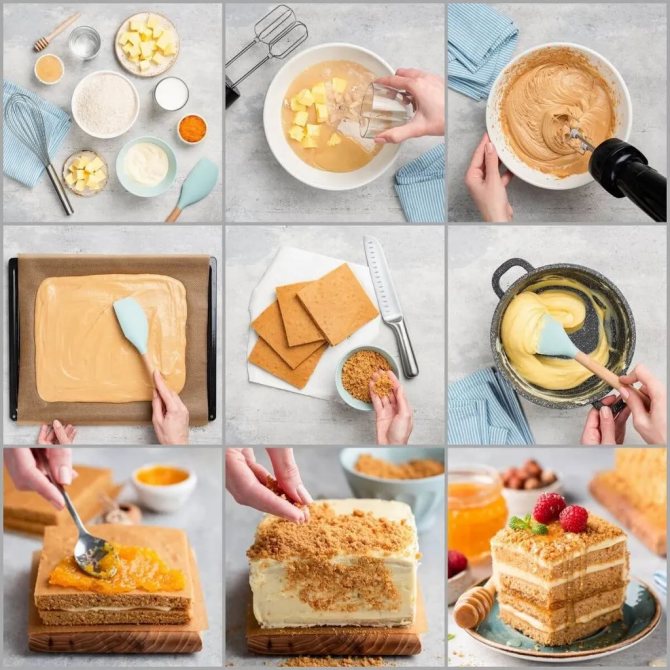
Joint activities with children: 5 interesting options
Quite often, parents believe that their joint activities with their child will not bring the desired effect. After all, in order to raise a comprehensively developed personality, we need specialists who master the most modern techniques.
In addition, mothers often refer to lack of time: “When should I draw with my child? I barely have time to feed him, check his lessons and go grocery shopping... Why waste precious free minutes on this?”
Of course, developmental circles are useful for any child, but they do not exclude or replace joint activities with loved ones. After all, it is at home that children can try in practice what they were taught in the courses. In addition, only at home can a child develop the most important social skills - the ability to listen, conduct dialogue, show participation, care for others and express his feelings. Without parental support, a child simply cannot learn all this.
1 Family Collection
Especially recommended for overly emotional and anxious children.
Gathering is a very rewarding activity. It gives us a feeling of stability. Have you noticed that often, after experiencing emotional excitement, kids shake out all their toys and, sorting through them, gradually calm down? Or do they carefully arrange cars and dolls in a certain way before going to bed? This ritual has a calming effect on them. Having grown up, children refuse stuffed hares, and just at this moment parents can invite them to collect something together.
If you already have a ready-made collection, invite your child to add to it. You can combine this process with the study of history, physics or something else. The topic depends on the subject of the collection. But whatever it is, such an activity is a great way to bring children and parents together. You can start now!
2 Go study
Especially recommended for: insecure primary schoolchildren and teenagers.
There are situations that seem to be specially created to praise children. That is, tell them how talented they are (smart, resourceful, etc.) immediately at the moment of success. You can, for example, study languages together. Or go to a dance with your daughter, and take a computer graphics course with your son.
In a co-education situation, the child feels “on an equal footing” with his parents. He gets the opportunity to show that he is better than adults in some ways, and truly shines before our eyes. Don't hesitate to ask him for help if you can't understand a rule or learn a difficult move. For children - both toddlers and teenagers - such moments add self-confidence. The child also gains the most important experience of support. The opportunity to encourage your mother (“don’t worry, you will succeed!”) and help her achieve what she wants is priceless. And it greatly strengthens self-confidence.
3 We can do it!
Especially recommended for: children who are not responsible enough.
The opportunity to help mother with housework creates a child’s sense of self-worth and, most importantly, teaches him to bear responsibility. The main condition of the process is to do everything together. The directive scheme “I bake a cake, and then you wash the dishes” is not suitable. After such instructions, any housework becomes a boring chore. The task of adults is to turn it into a joint game, and then the child will perceive even washing the floors as an adventure. Among other things, this is also a great way to relieve all family members from the feeling of “household routine”.
Do not miss
- Do not miss
Fun with kids: 11 ways to make slime from shampoo (you'll love it too)
4 Expressing feelings
Especially recommended for: introverted children who have difficulty expressing their feelings.
Parents of an introverted child sometimes have no idea what worries, upsets, or, conversely, makes him happy. He constantly holds back his emotions. Over time, secrecy becomes almost the main character trait, and then it becomes almost impossible to force a person to be frank. Free creativity will help teach your child to express and share emotions. It provides a huge toolkit that allows you to talk about your joys, sorrows and fears without words (introverts have plenty of them). The adult’s task is to show the child all the ways that are acceptable for working with feelings. Clubs are more focused on the technical side of the process, and parents can help their child “have a blast.”
5 Don't rush anywhere
Especially recommended for: children experiencing lack of attention.
Lying on the couch, playing with a kitten, thinking “what should I do?” - it’s so meaningless, aimless and... very useful. For a child, moments of relaxed “doing nothing” with their parents become one of the most pleasant and warm memories. The secret is that we can only laze around from the bottom of our hearts with truly dear people. The lazy activity of “nonsense” sometimes turns out to be the most bonding thing: adults do not make comments to the child, do not read notations, do not remember the “C in algebra,” but simply enjoy life with him. The time when we are together and not in a hurry is the most valuable time for a family!
Top 5 board games
Board games are perhaps the most accessible form of family entertainment. This is a useful, fun and exciting activity. Moreover, there are many games that are equally interesting to kids, teenagers, and mom and dad.
✓ “Monopoly” from 5 years, minimum 3 players. This classic economic strategy with fun twists has been at the top of the list of the world's most popular board games for many years. Gambling, witty and extremely useful (learning to count money) entertainment for all family members.
✓ “Nonsense” from 3 years old, minimum 2 players. This game develops speech, imagination and... a sense of humor! “Nonsense” does not require any costs: take a notebook and pencils and invite all participants to take turns writing words, so that the result is a funny story. Crazy stories are welcome!
✓ “Ropes and Dragons” from 6 years old, minimum 3 players. An educational and witty strategic thinking trainer. You throw the dice, make a move on the playing field and receive a certain task (they are written on the cards). Until you cope, you won’t go further. The winner is the one who reaches the finishing point first.
✓ “Danettes” from 5 years old, minimum 3 players. The presenter takes a card from the deck and reads aloud the story written on it (the explanation is written on the back and the presenter knows it). The participants' task is to get to the bottom of the story by asking questions that can only be answered with “yes” or “no.” The one who names the correct answer first becomes the new leader.
✓ “Bazinga” from 12 years old, minimum 4 players. Two teams with an even number of players compete against each other. Using special cards and a tape measure, a word is selected (there are different levels of difficulty), which must be drawn, shown in pantomime, or described without using the same root words.

